Potentiality of Actinomycetia Prevalent in Selected Forest Ecosystems in Assam, India to Combat Multi-Drug-Resistant Microbial Pathogens
Abstract
:1. Introduction
2. Materials and Methods
2.1. Isolation of Pathogens from Urine Samples and In Vitro Antibiotic Susceptibility Testing
2.2. Soil Sample Collection Site and Isolation of Actinomycetia from the Soil Samples
2.3. Model Pathogens for In Vitro Antimicrobial Bioassay
2.4. Evaluation of Actinomycetia against Model Pathogens and MDR Pathogens
2.5. Determination of Minimum Inhibitory Concentration (MIC)
2.6. Morphological Effect of Actinomycetia Isolate on Model Pathogen and MDR Pathogen
2.7. Molecular Characterization
2.7.1. Genomic DNA Extraction and PCR Amplification of 16S rRNA Gene
2.7.2. Molecular Identification and Phylogenetic Analysis
2.7.3. Detection of Secondary Metabolite Synthesis Genes (NRPS and PKS-II)
2.8. Gas Chromatography–Mass Spectrometry (GC-MS) Analysis
2.9. Whole-Genome Sequencing Assembly and Annotation
2.10. Statistical Analysis
3. Results
3.1. Isolation and In Vitro Antibiotic Susceptibility Profile of MDR Pathogens
3.2. Isolation and In Vitro Antimicrobial Bioassay of Actinomycetia against Model Pathogens and MDR Pathogens
3.3. Minimum Inhibitory Concentration (MIC) Assay
3.4. Molecular Characterization and Phylogenetic Analysis of Actinomycetia Isolates Using 16S rRNA Sequences
3.5. Detection of Biosynthetic (PKS-II and NRPS) Genes
3.6. Gas Chromatography–Mass Spectrometry Analysis
3.7. Genome Structure of Three Actinomycetia Strains
3.8. Identification of Biosynthetic Gene Clusters and Antibiotic Resistant Genes
4. Discussion
5. Conclusions
Supplementary Materials
Author Contributions
Funding
Institutional Review Board Statement
Informed Consent Statement
Data Availability Statement
Acknowledgments
Conflicts of Interest
References
- Miller, W.R.; Munita, J.M.; Arias, C.A. Mechanisms of antibiotic resistance in enterococci. Expert Rev. Anti-Infect. Ther. 2014, 12, 1221–1236. [Google Scholar] [CrossRef]
- De Simeis, D.; Serra, S. Actinomycetes: A never-ending source of bioactive compounds—An overview on antibiotics production. Antibiotics 2021, 10, 483. [Google Scholar] [CrossRef]
- Temkin, E.; Fallach, N.; Almagor, J.; Gladstone, B.P.; Tacconelli, E.; Carmeli, Y. Estimating the number of infections caused by antibiotic-resistant Escherichia coli and Klebsiella pneumoniae in 2014: A modelling study. Lancet Glob. Health. 2018, 6, e969–e979. [Google Scholar] [CrossRef] [Green Version]
- Akinyemi, K.O.; Abegunrin, R.O.; Iwalokun, B.A.; Fakorede, C.O.; Makarewicz, O.; Neubauer, H.; Wareth, G. The Emergence of Klebsiella pneumoniae with reduced susceptibility against third generation cephalosporins and carbapenems in Lagos Hospitals, Nigeria. Antibiotics 2021, 10, 142. [Google Scholar] [CrossRef] [PubMed]
- World Health Organization. Antimicrobial Resistance. Available online: https://www.who.int/news-room/fact-sheets/detail/antimicrobial-resistance (accessed on 22 February 2022).
- Mazumdar, R.; Thakur, D. Therapeutic Applications of Nanotechnology in the Prevention of Infectious Diseases. In Emerging Nanomaterials for Advanced Technologies; Springer International Publishing: Cham, Switzerland, 2022; pp. 323–343. [Google Scholar] [CrossRef]
- Mazumdar, R.; Dutta, P.P.; Saikia, J.; Borah, J.C.; Thakur, D. Streptomyces sp. Strain PBR11, a Forest-Derived Soil Actinomycetia with Antimicrobial Potential. Microbiol. Spectr. 2023, 11, e0348922. [Google Scholar] [CrossRef] [PubMed]
- Hazarika, S.N.; Thakur, D. Actinobacteria. In Beneficial Microbes in Agro-Ecology; Academic Press: Cambridge, MA, USA, 2020; pp. 443–476. [Google Scholar] [CrossRef]
- Donald, L.; Pipite, A.; Subramani, R.; Owen, J.; Keyzers, R.A.; Taufa, T. Streptomyces: Still the biggest producer of new natural secondary metabolites, a current perspective. Microbiol. Res. 2022, 13, 418–465. [Google Scholar] [CrossRef]
- Medema, M.H.; Trefzer, A.; Kovalchuk, A.; Van Den Berg, M.; Müller, U.; Heijne, W.; Wu, L.; Alam, M.T.; Ronning, C.M.; Nierman, W.C.; et al. The sequence of a 1.8-Mb bacterial linear plasmid reveals a rich evolutionary reservoir of secondary metabolic pathways. Genome Biol. Evol. 2010, 2, 212–224. [Google Scholar] [CrossRef]
- Hu, D.; Sun, C.; Jin, T.; Fan, G.; Mok, K.M.; Li, K.; Lee, S.M.Y. Exploring the potential of antibiotic production from rare actinobacteria by whole-genome sequencing and guided MS/MS analysis. Front. Microbiol. 2020, 11, 1540. [Google Scholar] [CrossRef] [PubMed]
- Newman, D.J.; Cragg, G.M. Natural products as sources of new drugs over the nearly four decades from 01/1981 to 09/2019. J. Nat. Prod. 2020, 83, 770–803. [Google Scholar] [CrossRef] [Green Version]
- Atanasov, A.G.; Zotchev, S.B.; Dirsch, V.M.; Supuran, C.T. Natural products in drug discovery: Advances and opportunities. Nat. Rev. Drug Discov. 2021, 20, 200–216. [Google Scholar] [CrossRef]
- Singh, B.P.; Rateb, M.E.; Rodriguez-Couto, S.; Polizeli, M.D.L.T.D.M.; Li, W.J. Microbial secondary metabolites: Recent developments and technological challenges. Front. Microbiol. 2019, 10, 914. [Google Scholar] [CrossRef] [PubMed]
- Zhang, X.Y.; Han, X.X.; Chen, X.L.; Dang, H.Y.; Xie, B.B.; Qin, Q.L.; Zhang, Y.Z. Diversity of cultivable protease-producing bacteria in sediments of Jiaozhou Bay, China. Front. Microbiol. 2019, 10, 1404. [Google Scholar] [CrossRef] [PubMed] [Green Version]
- Saravanan, D.; Bharathi, S.; Radhakrishnan, M.; Balagurunathan, R. Exploitation of bacteria from forest ecosystem for antimicrobial compounds. Appl. Pharm. Sci. 2012, 30, 120–123. [Google Scholar] [CrossRef]
- Lladó, S.; López-Mondéjar, R.; Baldrian, P. Forest soil bacteria: Diversity, involvement in ecosystem processes, and response to global change. Microbiol. Mol. Biol. Rev. 2017, 81, e00063-16. [Google Scholar] [CrossRef] [Green Version]
- Jiang, Y.; Li, Q.; Chen, X.; Jiang, C. Isolation and cultivation methods of Actinobacteria. In Actinobacteria-Basics and Biotechnological Applications; Intechopen: London, UK, 2016; pp. 39–57. [Google Scholar] [CrossRef] [Green Version]
- Jiang, Y.; Cao, Y.R.; Wiese, J.; Lou, K.; Zhao, L.X.; Imhoff, J.F.; Jiang, C.L. A new approach of research and development on pharmaceuticls from actinomycetes. J. Life Sci. 2009, 3, 52–56. [Google Scholar]
- Hug, J.J.; Bader, C.D.; Remškar, M.; Cirnski, K.; Müller, R. Concepts and methods to access novel antibiotics from actinomycetes. Antibiotics 2018, 7, 44. [Google Scholar] [CrossRef] [Green Version]
- Sharma, P.; Thakur, D. Antimicrobial biosynthetic potential and diversity of culturable soil actinobacteria from forest ecosystems of Northeast India. Sci. Rep. 2020, 10, 4104. [Google Scholar] [CrossRef] [PubMed] [Green Version]
- Schneider, Y.K. Bacterial natural product drug discovery for new antibiotics: Strategies for tackling the problem of antibiotic resistance by efficient bioprospecting. Antibiotics 2021, 10, 842. [Google Scholar] [CrossRef]
- Available online: https://www.studocu.com/in/document/university-of-kerala/tourism-society/the-biodiversity-of-assam/26012545 (accessed on 21 April 2023).
- Pezzlo, M. Detection of urinary tract infections by rapid methods. Clin. Microbiol. Rev. 1988, 1, 268–280. [Google Scholar] [CrossRef]
- CLSI. Performance Standards for Antimicrobial Susceptibility Testing, 30th ed.; CLSI supplement M100; Clinical and Laboratory Standards Institute: Wayne, PA, USA, 2020. [Google Scholar]
- Kumar, V.; Bharti, A.; Gusain, O.; Bisht, G.S. Scanning electron microscopy of Streptomyces without use of any chemical fixatives. Scanning 2011, 33, 446–449. [Google Scholar] [CrossRef] [PubMed]
- Grammer, A. Antibiotic sensitivity and Assay test. In Microbiological Methods; Collins, C.H., Lyne, P.M., Eds.; Butterworths Co. Ltd.: London, UK, 1976. [Google Scholar]
- Wu, H.; Zhang, Z.; Hu, S.; Yu, J. On the molecular mechanism of GC content variation among eubacterial genomes. J. Bacteriol. 1991, 173, 697–703. [Google Scholar] [CrossRef] [PubMed] [Green Version]
- Altschul, S.F.; Gish, W.; Miller, W.; Myers, E.W.; Lipman, D.J. Basic local alignment search tool. J. Mol. Biol. 1990, 215, 403–410. [Google Scholar] [CrossRef]
- Kumar, S.; Stecher, G.; Tamura, K. MEGA X: Molecular Evolutionary Genetics Analysis across Computing Platforms. Mol. Biol. Evol. 2018, 33, 1870–1874. [Google Scholar] [CrossRef] [Green Version]
- Felsenstein, J. Confidence limits on phylogenies: An approach using the bootstrap. Evolution 1985, 39, 783–791. [Google Scholar] [CrossRef]
- Ayuso-Sacido, A.; Genilloud, O. New PCR primers for the screening of NRPS and PKS-I systems in actinomycetes: Detection and distribution of these biosynthetic gene sequences in major taxonomic groups. Microb. Ecol. 2005, 49, 10–24. [Google Scholar] [CrossRef]
- Bolger, A.M.; Lohse, M.; Usadel, B. Trimmomatic: A flexible trimmer for Illumina sequence data. Bioinformatics 2014, 30, 2114–2120. [Google Scholar] [CrossRef] [Green Version]
- Wick, R.R.; Judd, L.M.; Gorrie, C.L.; Holt, K.E. Unicycler: Resolving bacterial genome assemblies from short and long sequencing reads. PLoS Comput. Biol. 2017, 13, e1005595. [Google Scholar] [CrossRef] [Green Version]
- Gurevich, A.; Saveliev, V.; Vyahhi, N.; Tesler, G. QUAST: Quality assessment tool for genome assemblies. Bioinformatics 2013, 29, 1072–1075. [Google Scholar] [CrossRef] [Green Version]
- Manni, M.; Berkeley, M.R.; Seppey, M.; Simão, F.A.; Zdobnov, E.M. BUSCO update: Novel and streamlined workflows along with broader and deeper phylogenetic coverage for scoring of eukaryotic, prokaryotic, and viral genomes. Mol. Biol. Evol. 2021, 38, 4647–4654. [Google Scholar] [CrossRef] [PubMed]
- Simão, F.A.; Waterhouse, R.M.; Ioannidis, P.; Kriventseva, E.V.; Zdobnov, E.M. BUSCO: Assessing genome assembly and annotation completeness with single-copy orthologs. Bioinformatics 2015, 31, 3210–3212. [Google Scholar] [CrossRef] [Green Version]
- Zhao, Y.; Wu, J.; Yang, J.; Sun, S.; Xiao, J.; Yu, J. PGAP: Pan-genomes analysis pipeline. Bioinformatics 2012, 28, 416–418. [Google Scholar] [CrossRef] [PubMed] [Green Version]
- Ciufo, S.; Kannan, S.; Sharma, S.; Badretdin, A.; Clark, K.; Turner, S.; Di Cuccio, M. Using average nucleotide identity to improve taxonomic assignments in prokaryotic genomes at the NCBI. Int. J. Syst. Evol. Microbiol. 2018, 68, 2386. [Google Scholar] [CrossRef] [PubMed]
- Blin, K.; Shaw, S.; Kloosterman, A.M.; Charlop-Powers, Z.; Van Wezel, G.P.; Medema, M.H.; Weber, T. antiSMASH 6.0: Improving cluster detection and comparison capabilities. Nucleic Acids Res. 2021, 49, W29–W35. [Google Scholar] [CrossRef]
- Aziz, R.K.; Bartels, D.; Best, A.A.; DeJongh, M.; Disz, T.; Edwards, R.A.; Formsma, K.; Gerdes, S.; Glass, E.M.; Kubal, M.; et al. The RAST Server: Rapid annotations using subsystems technology. BMC Genom. 2008, 9, 75. [Google Scholar] [CrossRef] [Green Version]
- Crider, A.M.; Tita, T.T.; Wood, J.D.; Hinko, C.N. Esters of nipecotic and isonipecotic acids as potential anticonvulsants. Pharm. Sci. 1982, 71, 1214–1219. [Google Scholar] [CrossRef]
- Khachatoorian, R.; Micewicz, E.D.; Micewicz, A.; French, S.W.; Ruchala, P. Optimization of 1, 3-disubstituted urea-based inhibitors of Zika virus infection. Bioorg. Med. Chem. Lett. 2019, 29, 126626. [Google Scholar] [CrossRef]
- Chen, Y.; Zheng, J.; Zheng, F.; Wang, J.; Zhang, Y.; Gao, F.; Huang, Z.; Shi, G. Design, synthesis, and pharmacological evaluation of haloperidol derivatives as novel potent calcium channel blockers with vasodilator activity. PLoS ONE 2011, 6, e27673. [Google Scholar] [CrossRef]
- Schepens, W.; Van Haver, D.; Vandewalle, M.; De Clercq, P.J.; Bouillon, R.; Verstuyf, A. Synthesis and biological activity of 22-oxa CD-ring modified analogues of 1α, 25-dihydroxyvitamin D3: Spiro [5.5] undecane CF-ring analogues. Bioorg. Med. Chem. Lett. 2004, 14, 3889–3892. [Google Scholar] [CrossRef]
- Yerragunta, V.; Reddy, E.S.; Kishore, M.; Sadia, A.; Saba, A.; Fatima, S. A review on acridone derivatives and its importance. PharmaTutor 2015, 3, 27–29. [Google Scholar]
- Kennedy, B.J. Fluoxymesterone therapy in advanced breast cancer. N. Engl. J. Med. 1958, 259, 673–675. [Google Scholar] [CrossRef]
- Al-Othman, N.; Alhendi, A.; Ihbaisha, M.; Barahmeh, M.; Alqaraleh, M.; Al-Momany, B.Z. Role of CD44 in breast cancer. Breast Dis. 2020, 39, 1–13. [Google Scholar] [CrossRef]
- Niţă, I.; Niţipir, C.; Toma, Ş.A.; Limbău, A.M.; Pîrvu, E.; Bădărău, I.A. The importance of androgen receptors in breast cancer. Med. Pharm. Rep. 2021, 94, 273. [Google Scholar] [CrossRef]
- Lu, Z.; Xu, A.; Yuan, X.; Chen, K.; Wang, L.; Guo, T. Anticancer effect of resibufogenin on gastric carcinoma cells through the phosphoinositide 3 kinase/protein kinase B/glycogen synthase kinase 3β signaling pathway. Oncol. Lett. 2018, 16, 3297–3302. [Google Scholar] [CrossRef] [Green Version]
- Al-Salman, H.N. Isolation and diagnosis of phytochemicals extracted from pomegranate husks and study of the biological effect of extract [O-Veratramide] as an antimicrobial activity. Int. J. Green Pharm. 2018, 12. [Google Scholar] [CrossRef]
- Wesolowska, O.; Molnar, J.; Westman, G.; Samuelsson, K.; Kawase, M.; Ocsovszki, I.; Motohashi, N.; Michalak, K. Benzo [a] phenoxazines: A new group of potent P-glycoprotein inhibitors. In Vivo 2006, 20, 109–113. [Google Scholar]
- Ge, J.F.; Arai, C.; Yang, M.; Bakar, M.d.A.; Lu, J.; Ismail, N.S.; Wittlin, S.; Kaiser, M.; Brun, R.; Charman, S.A.; et al. Discovery of novel benzo [a] phenoxazine SSJ-183 as a drug candidate for malaria. ACS Med. Chem. Lett. 2010, 1, 360–364. [Google Scholar] [CrossRef] [Green Version]
- Tanner, L.; Evans, J.C.; Seldon, R.; Jordaan, A.; Warner, D.F.; Haynes, R.K.; Parkinson, C.J.; Wiesner, L. In vitro efficacies, ADME, and pharmacokinetic properties of phenoxazine derivatives active against Mycobacterium tuberculosis. Antimicrob. Agents Chemother. 2019, 63, e01010–e01019. [Google Scholar] [CrossRef]
- Giner-Larza, E.M.; Máñez, S.; Giner-Pons, R.M.; Recio, M.C.; Ríos, J.L. On the anti-inflammatory and anti-phospholipase A2 activity of extracts from lanostane-rich species. J. Ethnopharmacol. 2000, 73, 61–69. [Google Scholar] [CrossRef]
- Giustarini, D.; Milzani, A.; Dalle-Donne, I.; Tsikas, D.; Rossi, R. N-Acetylcysteine ethyl ester (NACET): A novel lipophilic cell-permeable cysteine derivative with an unusual pharmacokinetic feature and remarkable antioxidant potential. Biochem. Pharmacol. 2012, 84, 1522–1533. [Google Scholar] [CrossRef]
- Varkey, J. Debunking volatile anesthetic cost myths between sevoflurane and desflurane. Anesth. eJ. 2013, 1. [Google Scholar]
- World Health Organization. Report on Antimicrobial Resistance. 2021. Available online: https://www.who.int/news-room/fact-sheets/detail/antimicrobial-resistance (accessed on 17 November 2022).
- Sugianli, A.K.; Ginting, F.; Parwati, I.; de Jong, M.D.; van Leth, F.; Schultsz, C. Antimicrobial resistance among uropathogens in the Asia-Pacific region: A systematic review. JAC Antimicrob. Resist. 2021, 3, dlab003. [Google Scholar] [CrossRef]
- Grabe, M.; Bjerklund-Johansen, T.E.; Botto, H.; Çek, M.; Naber, K.G.; Tenke, P.; Wagenlehner, F. Guidelines on urological infections. Eur. Assoc. Urol. 2023, 182, 237–257. [Google Scholar]
- Available online: https://www.worldbank.org/en/topic/health/brief/antimicrobial-resistance-amr (accessed on 21 April 2021).
- Available online: https://www.unep.org/explore-topics/chemicals-waste/what-we-do/emerging-issues/antimicrobial-resistance-global-threat (accessed on 6 January 2023).
- Choudhary, S.; Singh, A.; Rani, M. Rhizosphere: Hotspot of Soil-Microbes-Plant Interaction; A Monthly Peer Reviewed Magazine for Agriculture and Allied Sciences; Springer: Singapore, 2020; Volume 80. [Google Scholar]
- Hartmann, A.; Schmid, M.; Tuinen, D.V.; Berg, G. Plant-driven selection of microbes. Plant Soil 2009, 321, 235–257. [Google Scholar] [CrossRef]
- Hill, P.; Krištůfek, V.; Dijkhuizen, L.; Boddy, C.; Kroetsch, D.; van Elsas, J.D. Land use intensity controls actinobacterial community structure. Microb. Ecol. 2011, 61, 286–302. [Google Scholar] [CrossRef] [PubMed] [Green Version]
- Thakur, D.; Yadav, A.; Gogoi, B.K.; Bora, T.C. Isolation and screening of Streptomyces in soil of protected forest areas from the states of Assam and Tripura, India, for antimicrobial metabolites. J. Mycol. Med. 2007, 17, 242–249. [Google Scholar] [CrossRef]
- Arai, T.; Mikami, Y. Chromogenicity of Streptomyces. Morphological identification of actinobacteria. Actinobacteria-basics and biotechnological applications. Appl. Microbiol. 2016, 23, 402–406. [Google Scholar] [CrossRef]
- Shivlata, L.; Satyanarayana, T. Thermophilic and alkaliphilic Actinobacteria: Biology and potential applications. Front. Microbiol. 2015, 6, 1014. [Google Scholar] [CrossRef]
- Zahroh, E.W.; Ningsih, F.; Sjamsuridzal, W. Detection of antimicrobial compounds from thermophilic actinomycetes using one strain many compounds [OSMAC] approach. Biolink 2022, 9, 76–94. [Google Scholar] [CrossRef]
- Kingsford, R.T.; Bino, G.; Finlayson, C.M.; Falster, D.; Fitzsimons, J.A.; Gawlik, D.E.; Thomas, R.F. Ramsar wetlands of international importance–improving conservation outcomes. Front. Environ. Sci. 2021, 9, 643367. [Google Scholar] [CrossRef]
- Cook, A.E.; Meyers, P.R. Rapid identification of filamentous actinomycetes to the genus level using genus-specific 16S rRNA gene restriction fragment patterns. Int. J. Syst. Evol. Microbiol. 2003, 53, 1907–1915. [Google Scholar] [CrossRef] [Green Version]
- Rutledge, P.J.; Challis, G.L. Discovery of microbial natural products by activation of silent biosynthetic gene clusters. Nat. Rev. Microbiol. 2015, 13, 509–523. [Google Scholar] [CrossRef] [PubMed]
- Lee, L.H.; Zainal, N.; Azman, A.S.; Eng, S.K.; Goh, B.H.; Yin, W.F.; Chan, K.G. Diversity and antimicrobial activities of actinobacteria isolated from tropical mangrove sediments in Malaysia. Sci. World J. 2014, 2014, 698178. [Google Scholar] [CrossRef] [PubMed] [Green Version]
- Stein, S.E. An integrated method for spectrum extraction and compound identification from gas chromatography/mass spectrometry data. J. Am. Soc. Mass Spectrom. 1999, 10, 770–781. [Google Scholar] [CrossRef] [Green Version]
- Babushkina, E.A.; Belokopytova, L.V.; Grachev, A.M.; Meko, D.M.; Vaganov, E.A. Variation of the hydrological regime of Bele-Shira closed basin in Southern Siberia and its reflection in the radial growth of Larix sibirica. Reg. Environ. Change Metabol. 2018, 17, 1725–1737. [Google Scholar] [CrossRef] [Green Version]
- Bachmann, B.O.; Van Lanen, S.G.; Baltz, R.H. Microbial genome mining for accelerated natural products discovery: Is a renaissance in the making? Ind. Microbiol. Biotech. 2014, 41, 175–184. [Google Scholar] [CrossRef] [Green Version]
- Arulprakasam, K.R.; Dharumadurai, D. Genome mining of biosynthetic gene clusters intended for secondary metabolites conservation in actinobacteria. Microb. Pathog. 2021, 161, 105252. [Google Scholar] [CrossRef]
- Ling, L.L.; Schneider, T.; Peoples, A.J.; Spoering, A.L.; Engels, I.; Conlon, B.P.; Lewis, K. A new antibiotic kills pathogens without detectable resistance. Nature 2015, 517, 455–459. [Google Scholar] [CrossRef]
- Guo, C.; Mandalapu, D.; Ji, X.; Gao, J.; Zhang, Q. Chemistry and biology of teixobactin. Chem. A Eur. J. 2017, 24, 5406–5422. [Google Scholar] [CrossRef]
- Hover, B.M.; Kim, S.H.; Katz, M.; Charlop-Powers, Z.; Owen, J.G.; Ternei, M.A.; Maniko, J.; Estrela, A.B.; Molina, H.; Park, S.; et al. Culture-independent discovery of the malacidins as calcium-dependent antibiotics with activity against multidrug-resistant Gram-positive pathogens. Nat. Microbiol. 2018, 3, 415–422. [Google Scholar] [CrossRef] [Green Version]
- Wu, C.; Shang, Z.; Lemetre, C.; Ternei, M.A.; Brady, S.F. Cadasides, calcium-dependent acidic lipopeptides from the soil metagenome that are active against multidrug-resistant bacteria. J. Am. Chem. Soc. 2019, 141, 3910–3919. [Google Scholar] [CrossRef]
- Guerrero-Garzón, J.F.; Zehl, M.; Schneider, O.; Rückert, C.; Busche, T.; Kalinowski, J.; Bredholt, H.; Zotchev, S.B. Streptomyces spp. from the marine sponge Antho dichotoma: Analyses of secondary metabolite biosynthesis gene clusters and some of their products. Front. Microbiol. 2020, 11, 437. [Google Scholar] [CrossRef] [Green Version]
- Naughton, L.M.; Romano, S.; O’Gara, F.; Dobson, A.D. Identification of secondary metabolite gene clusters in the Pseudo vibrio genus reveals encouraging biosynthetic potential toward the production of novel bioactive compounds. Front. Microbiol. 2017, 8, 1494. [Google Scholar] [CrossRef] [Green Version]
- Belknap, K.C.; Park, C.J.; Barth, B.M.; Andam, C.P. Genome mining of biosynthetic and chemotherapeutic gene clusters in Streptomyces bacteria. Sci. Rep. 2020, 10, 1–9. [Google Scholar] [CrossRef] [Green Version]
- Liu, Y.; Chen, X.; Li, Z.; Xu, W.; Tao, W.; Wu, J.; Sun, Y. Functional analysis of cytochrome P450s involved in streptovaricin biosynthesis and generation of anti-MRSA analogues. ACS Chem. Biol. 2017, 12, 2589–2597. [Google Scholar] [CrossRef]
- Zhao, H.; Wang, L.; Wan, D.; Qi, J.; Gong, R.; Deng, Z.; Chen, W. Characterization of the aurantimycin biosynthetic gene cluster and enhancing its production by manipulating two pathway-specific activators in Streptomyces aurantiacus JA 4570. Microb. Cell Fact. 2016, 15, 160. [Google Scholar] [CrossRef] [Green Version]
- Liu, W.T.; Lamsa, A.; Wong, W.R.; Boudreau, P.D.; Kersten, R.; Peng, Y.; Dorrestein, P.C. MS/MS-based networking and peptidogenomics guided genome mining revealed the stenothricin gene cluster in Streptomyces roseosporus. J. Antibiot. 2014, 67, 99–104. [Google Scholar] [CrossRef] [Green Version]
- Zheng, D.; Ding, N.; Jiang, Y.; Zhang, J.; Ma, J.; Chen, X.; Huang, X. Albaflavenoid, a new tricyclic sesquiterpenoid from Streptomyces violascens. J. Antibiot. 2016, 69, 773–775. [Google Scholar] [CrossRef]
- Belousoff, M.J.; Shapira, T.; Bashan, A.; Zimmerman, E.; Rozenberg, H.; Arakawa, K.; Yonath, A. Crystal structure of the synergistic antibiotic pair, lankamycin and lankacidin, in complex with the large ribosomal subunit. Proc. Natl. Acad. Sci. USA 2011, 108, 2717–2722. [Google Scholar] [CrossRef] [PubMed]
- Harada, S. Studies on Lankacidine-Group (T-2636) Antibiotics. VI. Chemical Structures of Lankacidin-Group Antibiotics. II. Chem. Pharm. Bull. 1975, 23, 2201–2210. [Google Scholar] [CrossRef] [PubMed] [Green Version]
- Rateb, M.E.; Houssen, W.E.; Arnold, M.; Abdelrahman, M.H.; Deng, H.; Harrison, W.T.; Jaspars, M. Chaxamycins A–D, bioactive ansamycins from a hyper-arid desert Streptomyces sp. J. Nat. Prod. 2011, 74, 1491–1499. [Google Scholar] [CrossRef] [PubMed]
- Corcilius, L.; Elias, N.T.; Ochoa, J.L.; Linington, R.G.; Payne, R.J. Total Synthesis of Glycinocins A–C. J. Org. Chem. 2017, 82, 12778–12785. [Google Scholar] [CrossRef] [PubMed]
- Cheng, P.; Xu, K.; Chen, Y.C.; Wang, T.T.; Chen, Y.; Yang, C.L.; Jiao, R.H. Cytotoxic aromatic polyketides from an insect derived Streptomyces sp. NA4286. Tetrahedron Lett. 2019, 60, 1706–1709. [Google Scholar] [CrossRef]
- He, X.; Li, M.; Song, S.; Wu, X.; Zhang, J.; Wu, G.; Zhang, H. Ficellomycin: An aziridine alkaloid antibiotic with potential therapeutic capacity. Appl. Microbiol. Biotechnol. 2018, 102, 4345–4354. [Google Scholar] [CrossRef]
- Sakoulas, G.; Nam, S.J.; Loesgen, S.; Fenical, W.; Jensen, P.R.; Nizet, V.; Hensler, M. Novel bacterial metabolite merochlorin A demonstrates in vitro activity against multi-drug resistant methicillin-resistant Staphylococcus aureus. PLoS ONE 2012, 7, e29439. [Google Scholar] [CrossRef]
- Deng, M.R.; Li, Y.; Luo, X.; Zheng, X.L.; Chen, Y.; Zhang, Y.L.; Zhu, H. Discovery of Mycothiogranaticins from Streptomyces vietnamensis GIMV4. 0001 and the Regulatory Effect of Mycothiol on the Granaticin Biosynthesis. Front. Chem. 2021, 9, 802279. [Google Scholar] [CrossRef]
- Lee, H.S.; An, B.J.; Kim, H.J.; Cho, Y.H.; Kim, D.I.; Jang, J.Y.; Shin, H.J. Anti-Inflammatory Effect of Violapyrones B and C from a Marine-derived Streptomyces sp. Nat. Prod. Sci. 2015, 21, 251–254. [Google Scholar] [CrossRef]
- Hou, L.; Huang, H.; Li, H.; Wang, S.; Ju, J.; Li, W. Overexpression of a type III PKS gene affording novel violapyrones with enhanced anti-influenza A virus activity. Microb. Cell Fact. 2018, 17, 61. [Google Scholar] [CrossRef] [Green Version]
- Son, S.; Hong, Y.S.; Jang, M.; Heo, K.T.; Lee, B.; Jang, J.P.; Ahn, J.S. Genomics-driven discovery of chlorinated cyclic hexapeptides ulleungmycins A and B from a Streptomyces species. J. Nat. Prod. 2017, 80, 3025–3031. [Google Scholar] [CrossRef]
- Xie, Y.; Ma, J.; Qin, X.; Li, Q.; Ju, J. Identification and utilization of two important transporters: SgvT1 and SgvT2, for griseoviridin and viridogrisein biosynthesis in Streptomyces griseoviridis. Microb. Cell Fact. 2017, 16, 177. [Google Scholar] [CrossRef] [Green Version]
- Lowell, A.N.; DeMars, M.D.; Slocum, S.T.; Yu, F.; Anand, K.; Chemler, J.A.; Sherman, D.H. Chemoenzymatic Total Synthesis and Structural Diversification of Tylactone-Based Macrolide Antibiotics through Late-Stage Polyketide Assembly, Tailoring, and C-H Functionalization. J. Am. Chem. Soc. 2017, 139, 7913–7920. [Google Scholar] [CrossRef] [PubMed]
- Hotta, K. Basic and applied research on multiple aminoglycoside antibiotic resistance of actinomycetes: An old-timer′s recollection. J. Ind. Microbiol. Biotechnol. 2021, 48, kuab059. [Google Scholar] [CrossRef]
- Fiedler, H.P. Abyssomicins—A 20-Year Retrospective View. Mar. Drugs 2021, 19, 299. [Google Scholar] [CrossRef] [PubMed]
- Liu, X.F.; Xiang, L.; Zhou, Q.; Carralot, J.P.; Prunotto, M.; Niederfellner, G.; Pastan, I. Actinomycin D enhances killing of cancer cells by immunotoxin RG7787 through activation of the extrinsic pathway of apoptosis. Proc. Natl. Acad. Sci. USA 2016, 113, 10666–10671. [Google Scholar] [CrossRef]
- Gionfriddo, I.; Brunetti, L.; Mezzasoma, F.; Milano, F.; Cardinali, V.; Ranieri, R.; Falini, B. Dactinomycin induces complete remission associated with nucleolar stress response in relapsed/refractory NPM1-mutated AML. Leukemia 2021, 35, 2552–2562. [Google Scholar] [CrossRef]
- Li, R.; Lloyd, E.P.; Moshos, K.A.; Townsend, C.A. Identification and characterization of the carbapenem MM 4550 and its gene cluster in Streptomyces argenteolus ATCC 11009. ChemBioChem 2014, 15, 320–331. [Google Scholar] [CrossRef] [Green Version]
- Schulze, C.J.; Bray, W.M.; Loganzo, F.; Lam, M.H.; Szal, T.; Villalobos, A.; Linington, R.G. Borrelidin B: Isolation, biological activity, and implications for nitrile biosynthesis. J. Nat. Prod. 2014, 77, 2570–2574. [Google Scholar] [CrossRef] [PubMed]
- Bae, M.; Chung, B.; Oh, K.B.; Shin, J.; Oh, D.C. Hormaomycins B and C: New antibiotic cyclic depsipeptides from a marine mudflat-derived Streptomyces sp. Mar. Drugs 2015, 13, 5187–5200. [Google Scholar] [CrossRef] [PubMed] [Green Version]
- Mojićević, M.; Grahovac, J.; Petković, M.; Vučković, I.; Dodić, J.; Dodić, S.; Vojnović, S. Production of nigericin and niphimycin by soil isolate Streptomyces sp. Ms1: Anti-Candida bioassay guided response surface methodology for the optimized culture medium. Facta Univ. Ser. Phys. Chem. Technol. 2017, 15, 1–16. [Google Scholar] [CrossRef] [Green Version]
- Fang, X.; Tiyanont, K.; Zhang, Y.; Wanner, J.; Boger, D.; Walker, S. The mechanism of action of ramoplanin and enduracidin. Mol. BioSyst. 2006, 2, 69–76. [Google Scholar] [CrossRef]
- Chen, Y.W.; Liu, X.C.; Lv, F.X.; Li, P. Characterization of three regulatory genes involved in enduracidin biosynthesis and improvement of enduracidin production in Streptomyces fungicidicus. J. Appl. Microbiol. 2019, 127, 1698–1705. [Google Scholar] [CrossRef]
- Boros, C.; Smith, C.J.; Vasina, Y.; Che, Y.; Dix, A.B.; Darveaux, B.; Pearce, C. Isolation and Identification of the Icosalides--Cyclic Peptolides with Selective Antibiotic and Cytotoxic Activities. J. Antibiot. 2006, 59, 486–494. [Google Scholar] [CrossRef]
- Phelan, J.J.; McQuaid, K.; Kenny, C.; Gogan, K.M.; Cox, D.J.; Basdeo, S.A.; Keane, J. Desferrioxamine supports metabolic function in primary human macrophages infected with Mycobacterium tuberculosis. Front. Immunol. 2020, 11, 836. [Google Scholar] [CrossRef]
- Greule, A.; Marolt, M.; Deubel, D.; Peintner, I.; Zhang, S.; Jessen-Trefzer, C.; Bechthold, A. Wide Distribution of Foxicin Biosynthetic Gene Clusters in Streptomyces Strains–An Unusual Secondary Metabolite with Various Properties. Front. Microbiol. 2017, 8, 221. [Google Scholar] [CrossRef] [Green Version]
- Du, Y.; Wang, Y.; Huang, T.; Tao, M.; Deng, Z.; Lin, S. Identification and characterization of the biosynthetic gene cluster of polyoxypeptin A, a potent apoptosis inducer. BMC Microbiol. 2014, 14, 30. [Google Scholar] [CrossRef] [Green Version]
- Shi, J.; Zeng, Y.J.; Zhang, B.; Shao, F.L.; Chen, Y.C.; Xu, X.; Ge, H.M. Comparative genome mining and heterologous expression of an orphan NRPS gene cluster direct the production of ashimides. Chem. Sci. 2019, 10, 3042–3048. [Google Scholar] [CrossRef] [Green Version]
- Ghosh, A.K.; Allu, S.R.; Reddy, G.C.; Lopez, A.G.; Mendez, P.; Jurica, M.S. Design and synthesis of herboxidiene derivatives that potently inhibit in vitro splicing. Org. Biomol. Chem. 2021, 19, 1365–1377. [Google Scholar] [CrossRef] [PubMed]
- Stankovic, N.; Senerovic, L.; Ilic-Tomic, T.; Vasiljevic, B.; Nikodinovic-Runic, J. Properties and applications of undecylprodigiosin and other bacterial prodigiosins. Appl. Microbiol. Biotechnol. 2014, 98, 3841–3858. [Google Scholar] [CrossRef]
- Choi, Y.H.; Sohn, J.H.; Lee, D.; Kim, J.K.; Kong, I.S.; Ahn, S.C.; Oh, H. Chejuenolides A and B, new macrocyclic tetraenes from the marine bacterium Hahella chejuensis. Tetrahedron Lett. 2008, 49, 7128–7131. [Google Scholar] [CrossRef]
- Thaker, M.N.; Wang, W.; Spanogiannopoulos, P.; Waglechner, N.; King, A.M.; Medina, R.; Wright, G.D. Identifying producers of antibacterial compounds by screening for antibiotic resistance. Nat. Biotechnol. 2013, 31, 922–927. [Google Scholar] [CrossRef] [PubMed]
- Bibikova, M.V.; Ivanitskaia, L.P.; Singal, E.M. Directed screening of aminoglycoside antibiotic producers on selective media with gentamycin. Antibiotiki 1981, 26, 488–492. [Google Scholar] [PubMed]
- Ivanitskaia, L.P.; Bibikova, M.V.; Gromova, M.N.; IuV, Z.; Istratov, E.N. Use of selective media with lincomycin for the directed screening of antibiotic producers. Antibiotiki 1981, 26, 83–86. [Google Scholar] [PubMed]
- Yim, G.; Wang, H.H. Davies, J. Antibiotics as signaling molecules. Phil. Trans. R. Soc. B 2007, 362, 1195–1200. [Google Scholar] [CrossRef] [PubMed] [Green Version]
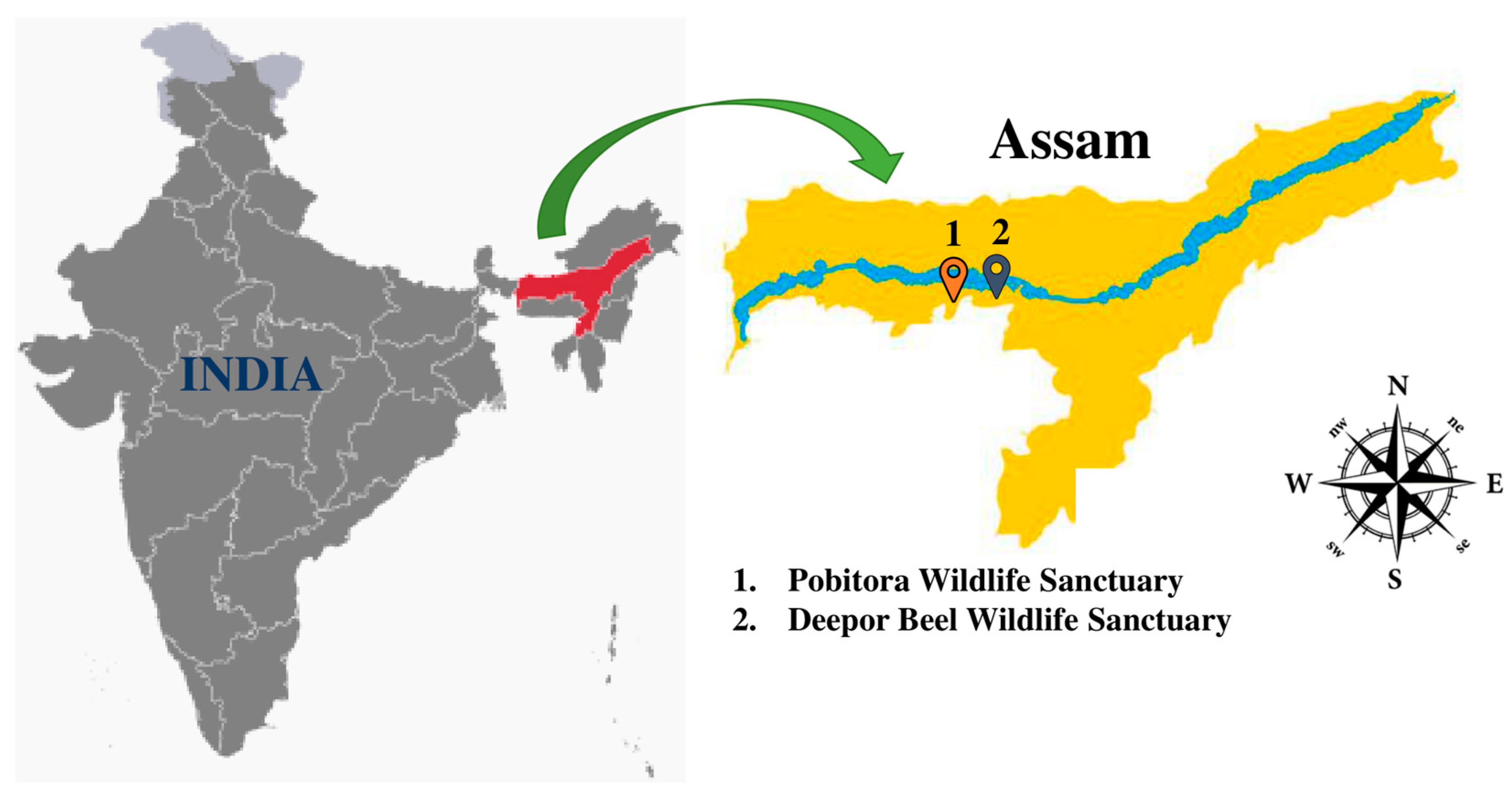
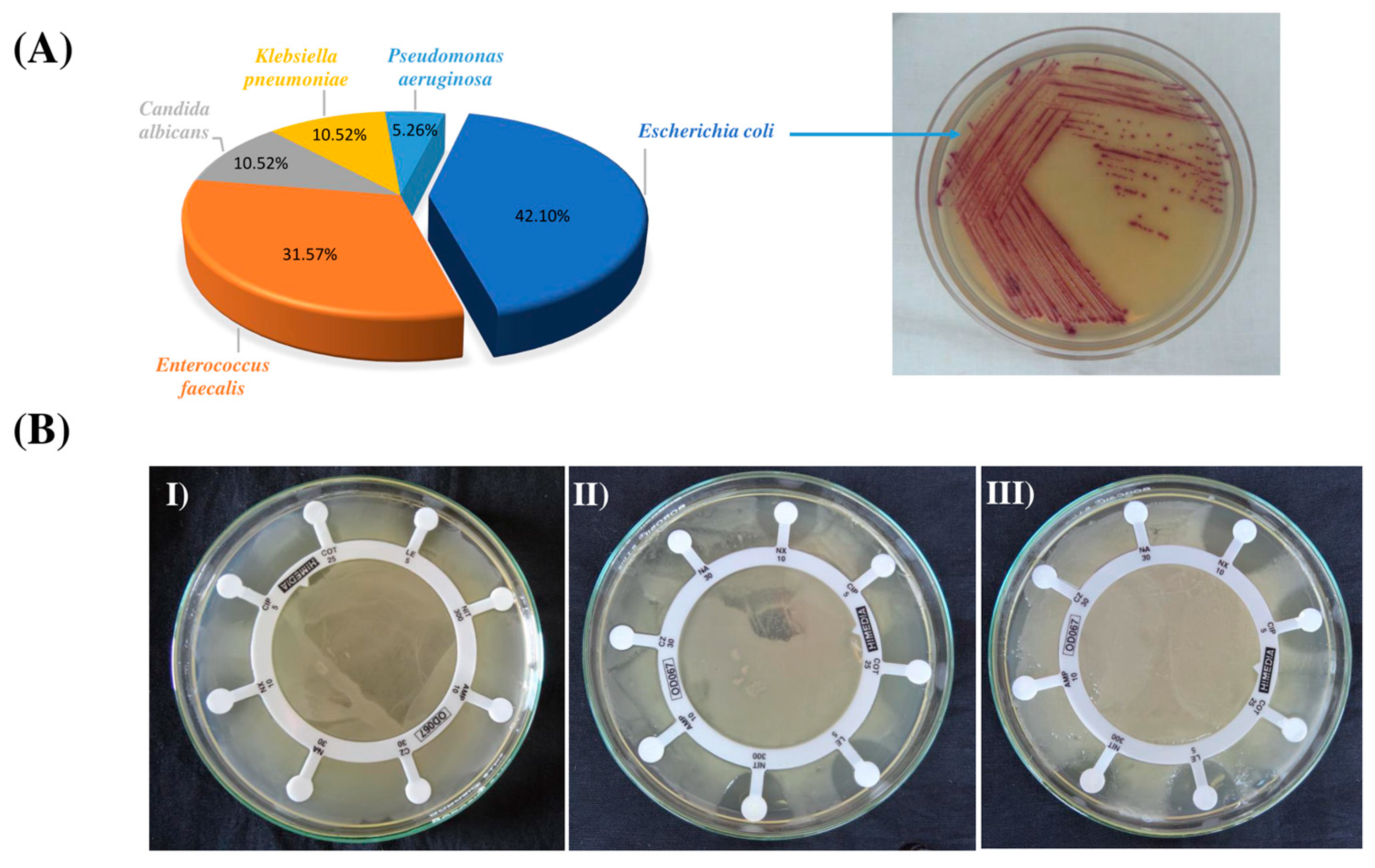
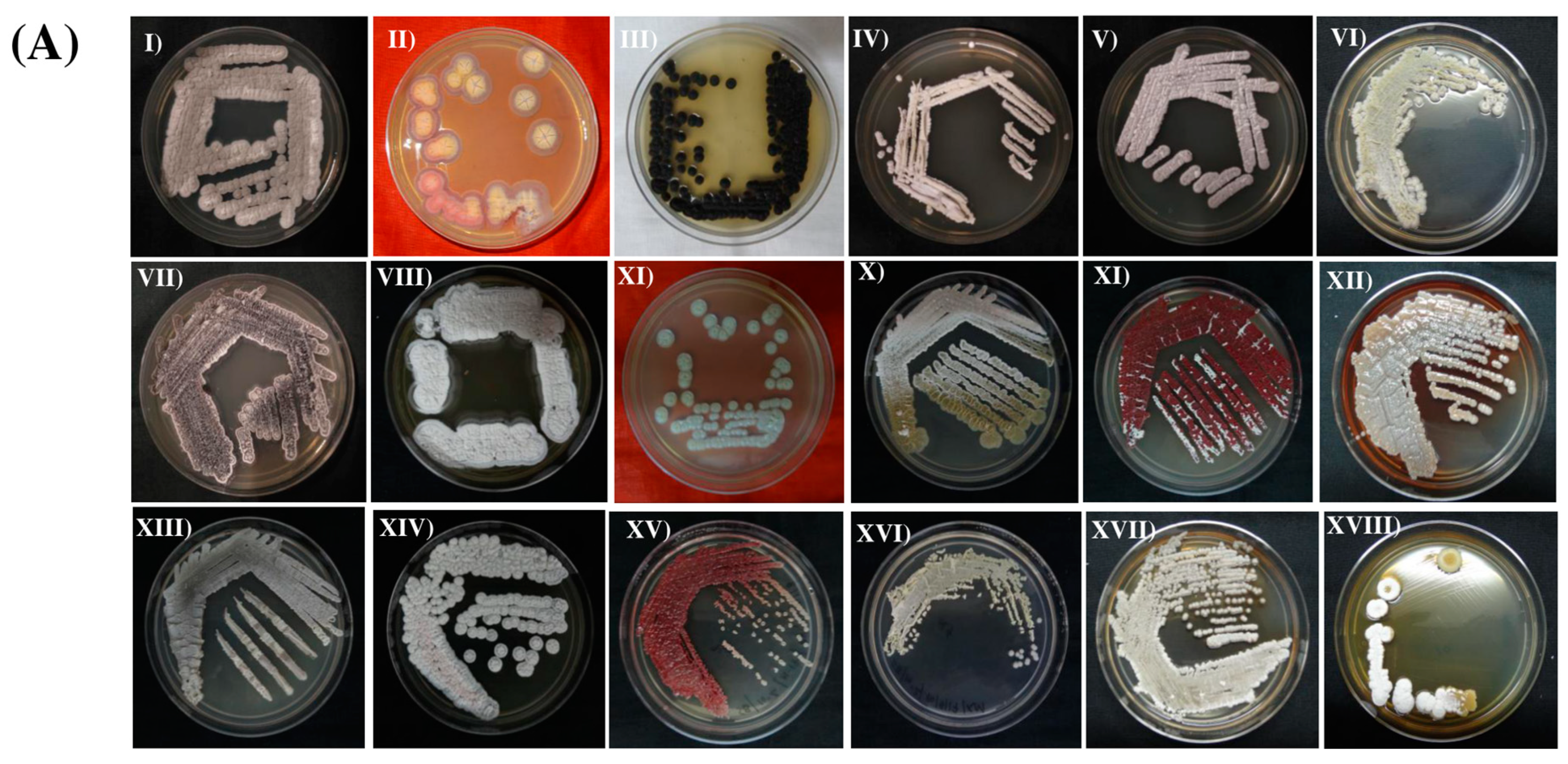

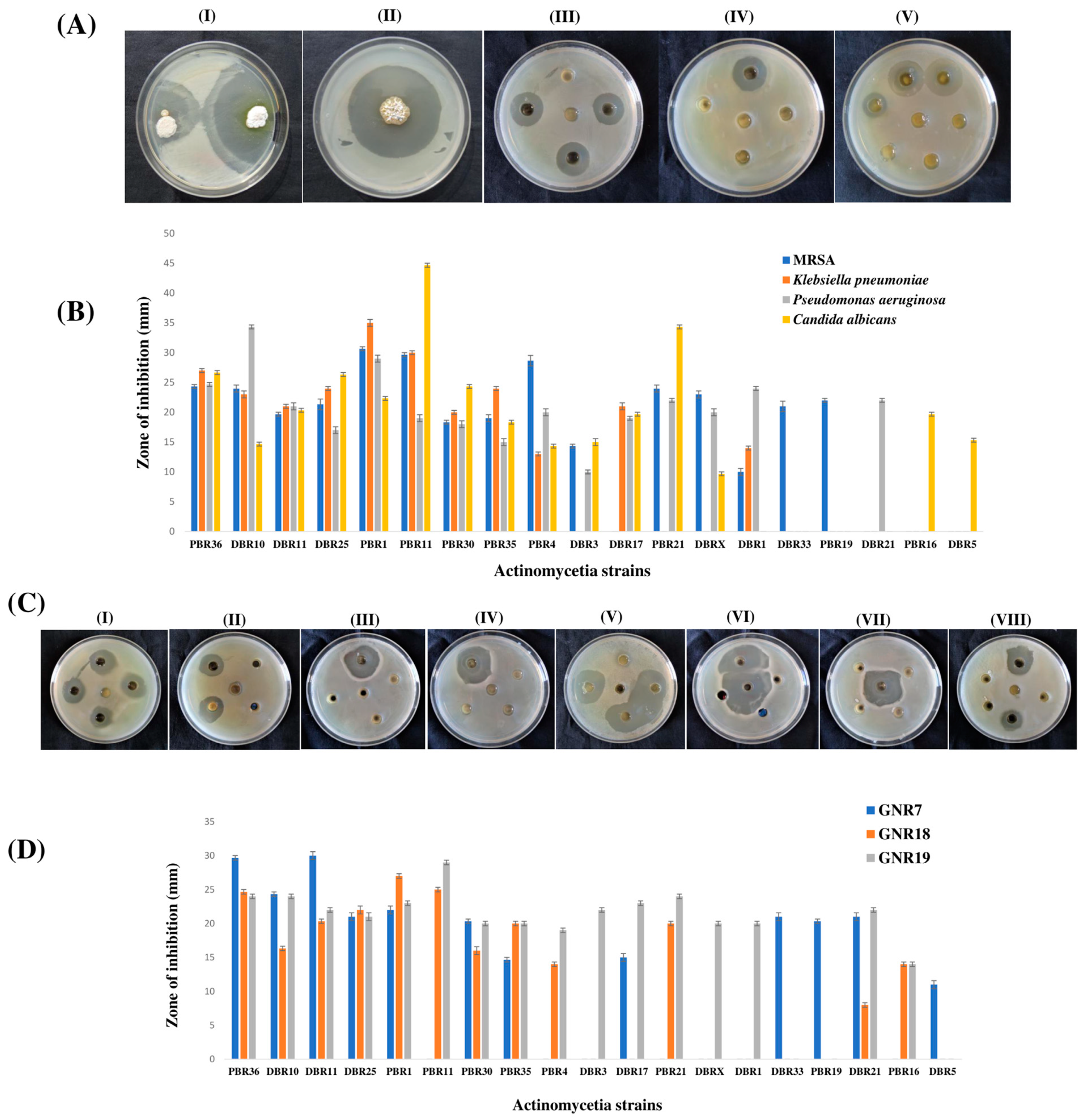
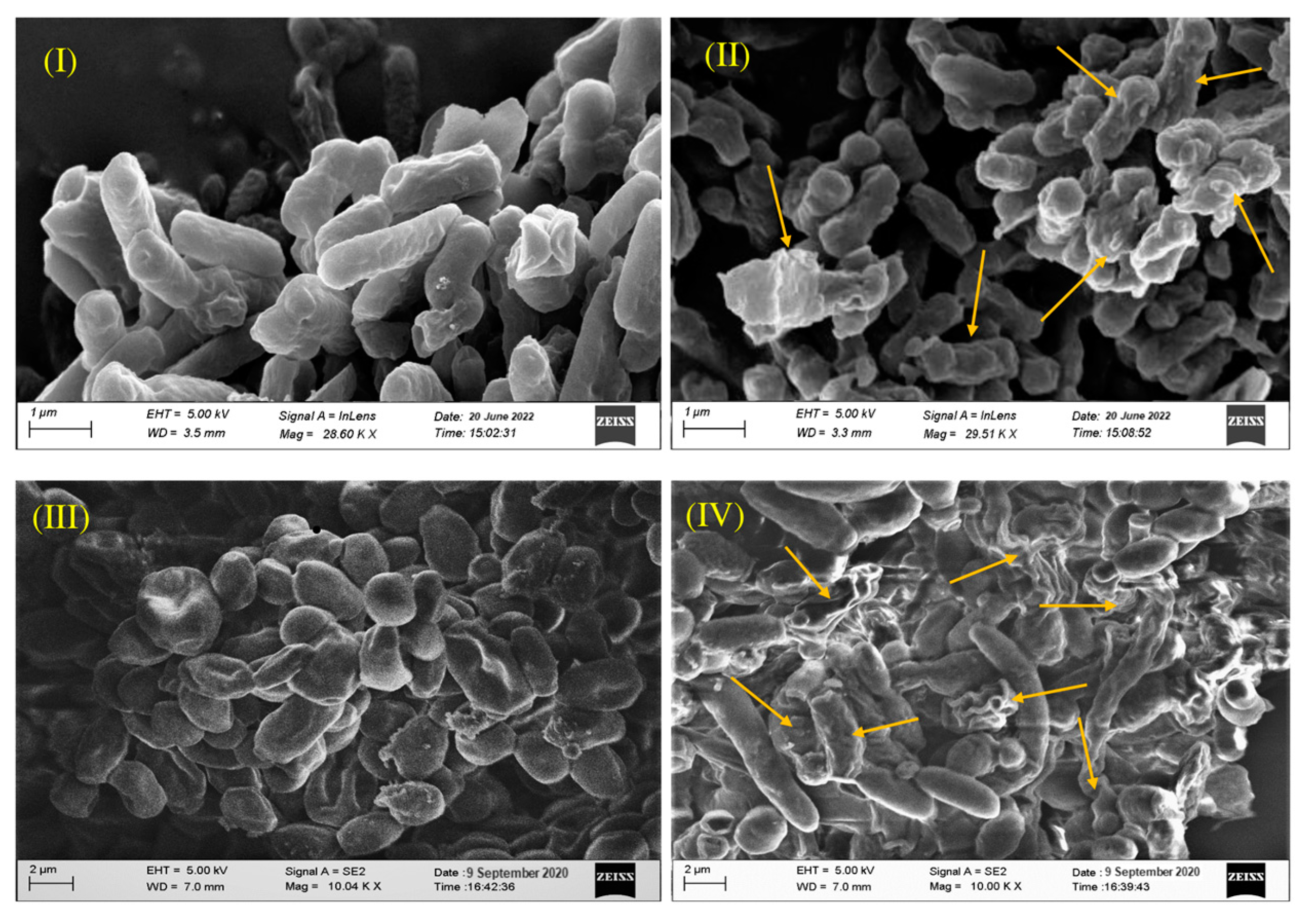
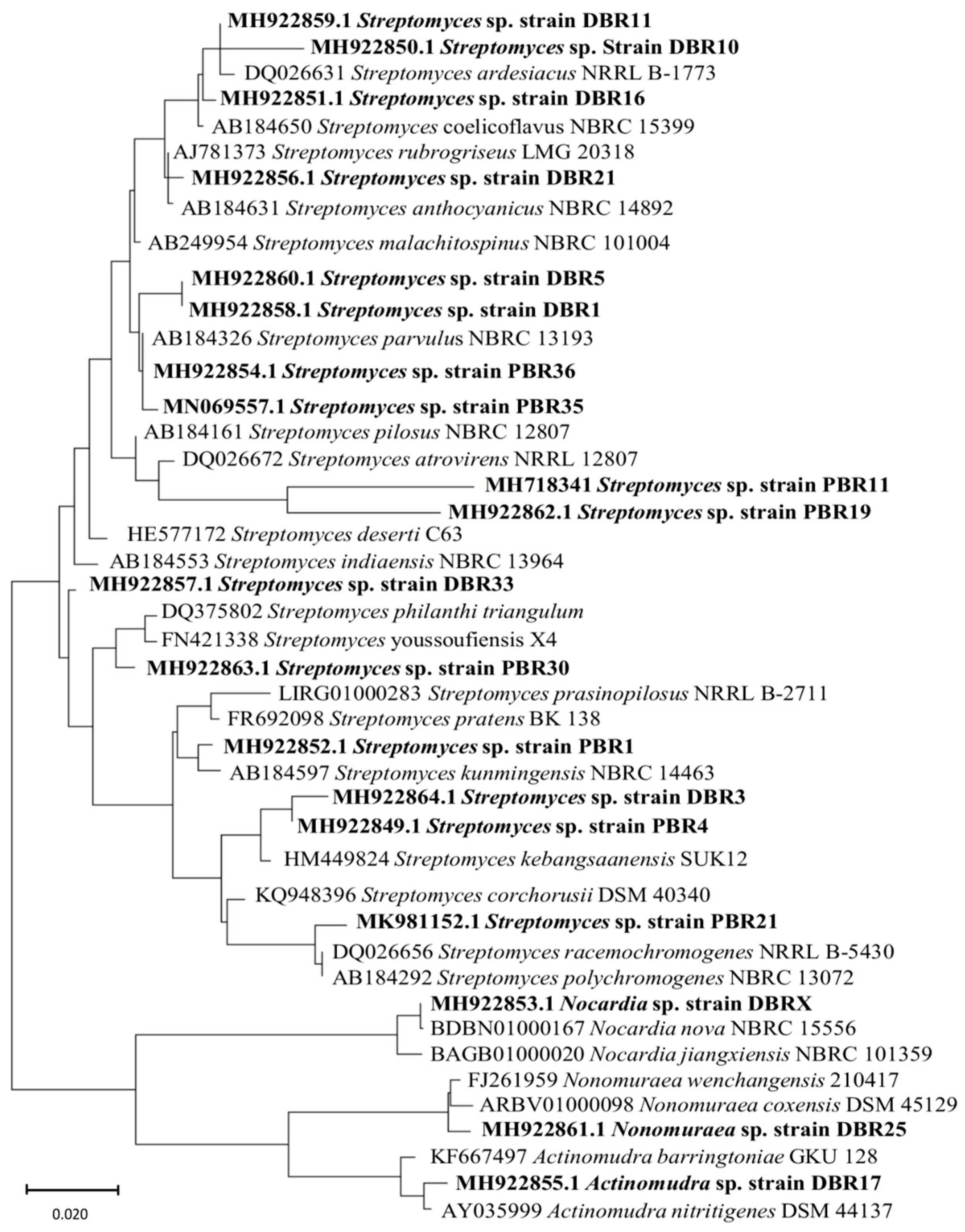
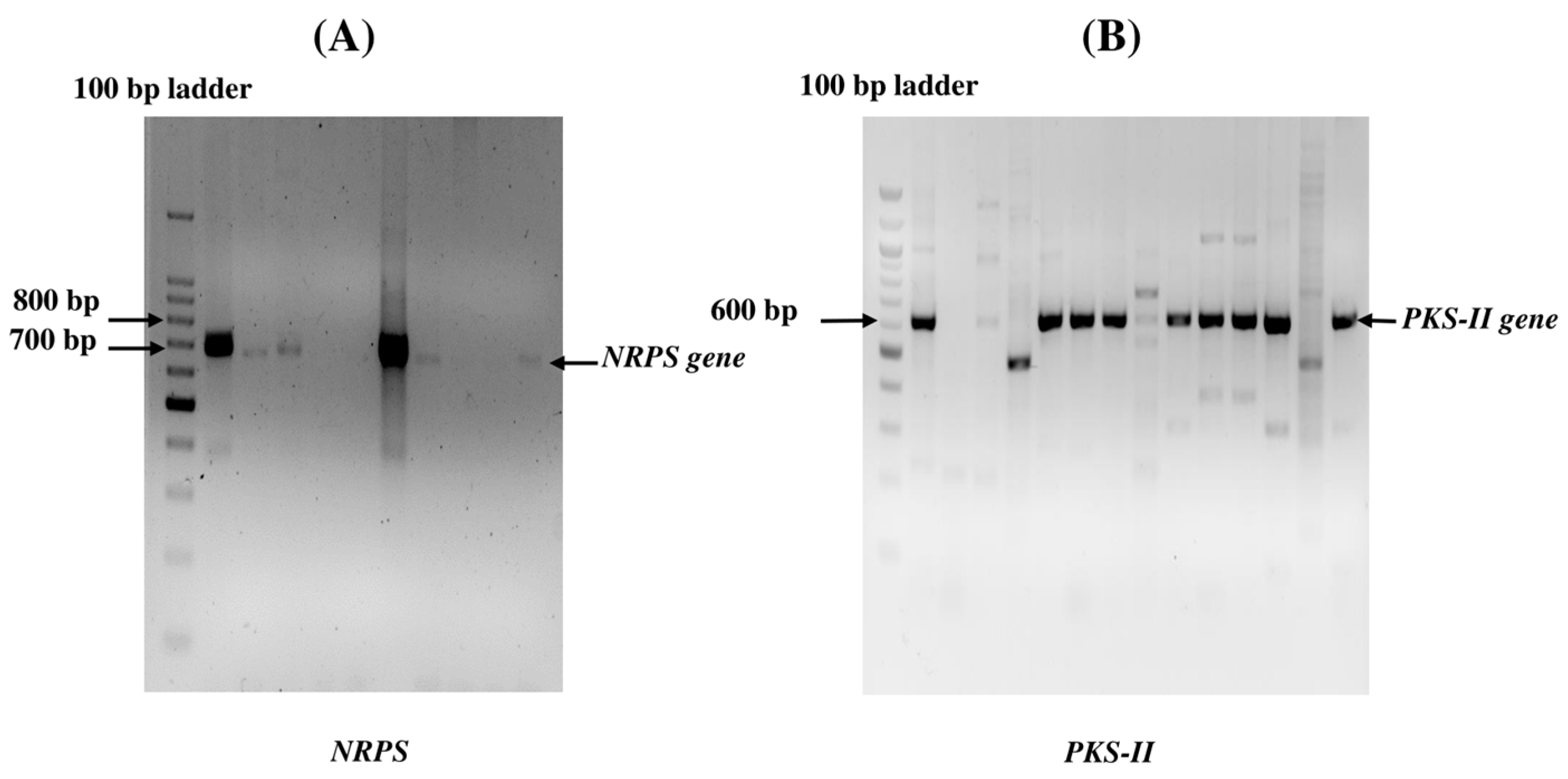

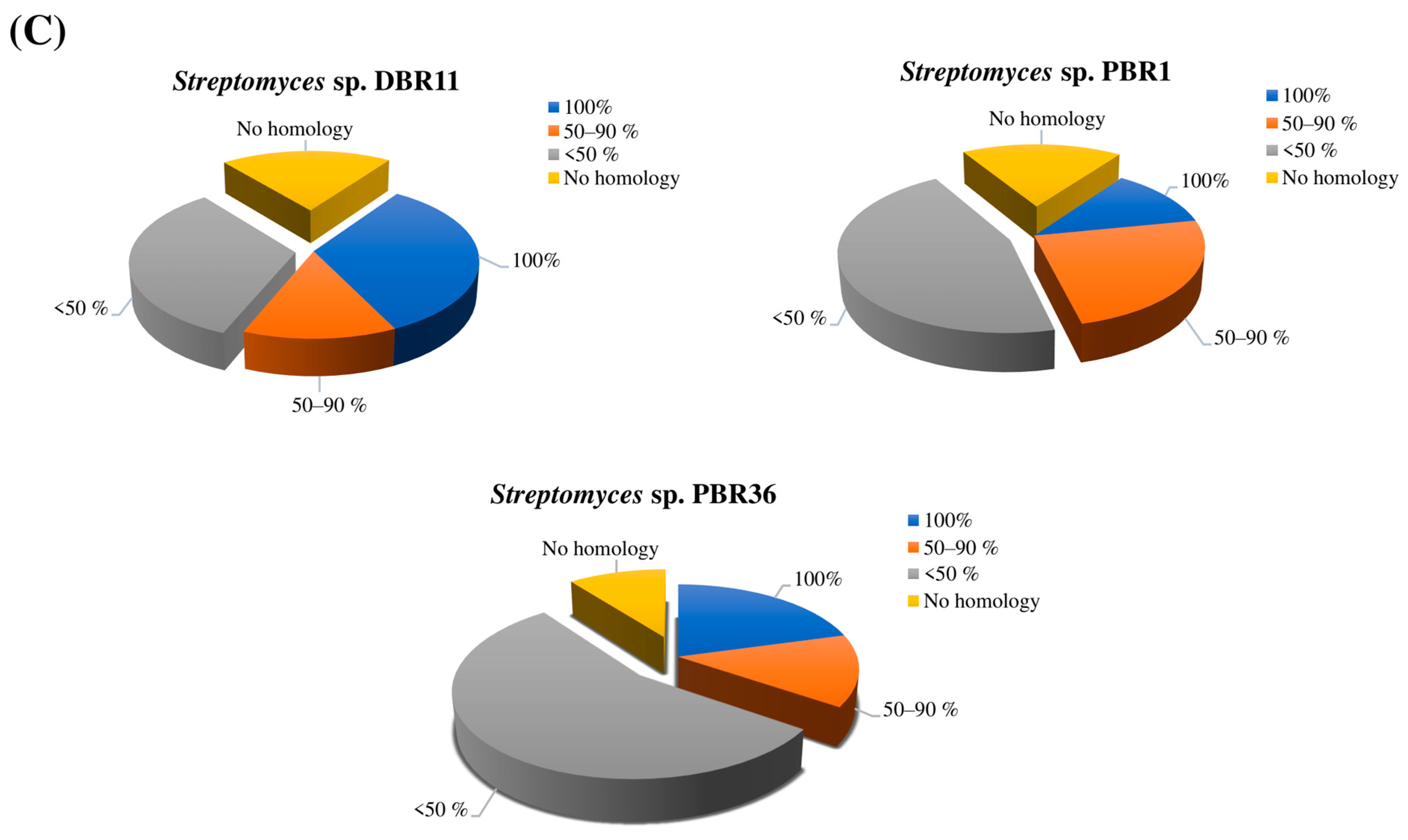
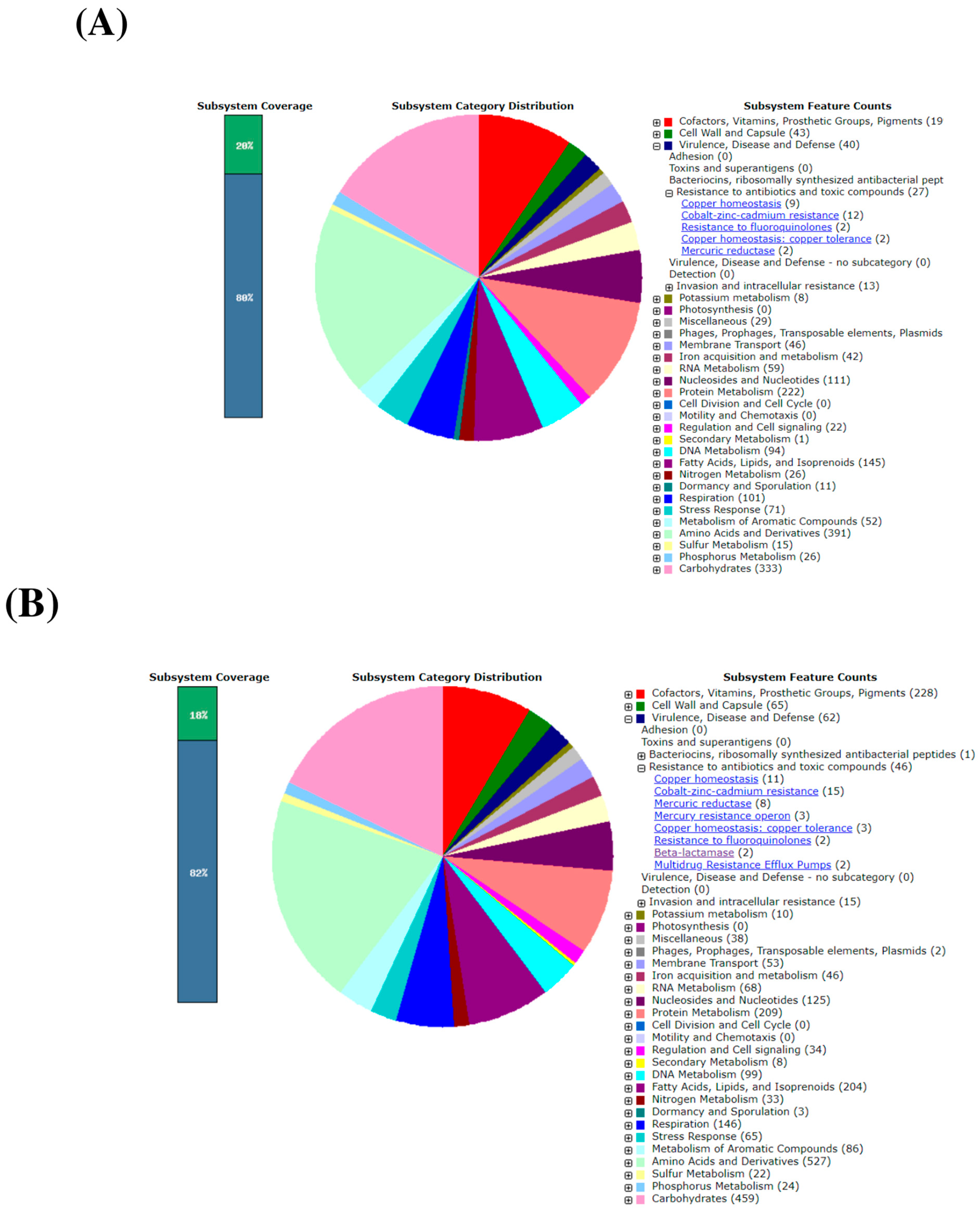

| Pathogens | |||
|---|---|---|---|
| MIC (µg/mL) | MRSA (Gram-Positive Bacteria) | Escherichia coli GNR19 (Gram-Negative Bacteria) | Candida albicans (Yeast) |
| MIC of EtAc-DBR11 | ≤3.125 | ≤12.50 | ≤0.97 |
| MIC of EtAc-PBR1 | ≤0.195 | ≤3.125 | ≤0.781 |
| MIC of EtAc-PBR36 | ≤0.781 | ≤.781 | ≤0.097 |
| MIC of Rifampicin | ≤25 | NA | NA |
| MIC of Amphotericin | NA | NA | ≤0.97 |
| MIC of Levofloxacin | NA | ≤8 | NA |
| Compound Name | RT | MW g/mol | Area (%) | Nature of Compound | Activity | References |
|---|---|---|---|---|---|---|
| (A) | ||||||
| 5-Amino-6-methoxy-8-nitroquinoline | 8.688 | 204.18 | 4.44 | Aromatic compound | No activity reported | - |
| Isonipecotic acid, N-[3-fluoro-5-trifluoromethylbenzoyl]-, eicosyl ester | 11.526 | 129.16 | 3.23 | Heterocyclic compound | Potential anticonvulsants | [42] |
| Acetic acid, hydrazino-, ethyl ester | 20.25 | 131.13 | 2.43 | Ethyl ester | No activity reported | - |
| 4-Bromo-2-trifluoromethylphenyl isothiocyanate | 24.905 | 282.08 | 2.42 | Phenyl | Inhibitor of Zika virus infection, antiviral | [43] |
| Haloperidol TMS derivative | 26.035 | 448 | 3.31 | Organofluoride compound | Vasodilator activity, novel potent calcium channel blockers | [44] |
| Spiro [5.5] undecane, 1-methylene | 28.725 | 164.29 | 3.77 | Alkene | Anticancer | [45] |
| 9-Acridanone, 1-ethoxy-3-methoxy-10- methyl- | 32.732 | 283.32 | 2.37 | Ketone | Anticancer, antimicrobial, antiviral, antimalarial, and anti-inflammatory activities | [46] |
| 1-Anthracenyl-2-pyridyl ketone | 36.602 | 283.30 | 3.94 | Ketone | No activity reported | - |
| Fluoxymesterone | 53.633 | 336.44 | 1.7 | Steroid | Anticancer, antianemia | [47,48,49] |
| (B) | ||||||
| Resibufogenin | 28.727 | 384.23 | 1.15 | Glycosides | Anticancer, anti-inflammation | [50] |
| o-Veratramide | 33.365 | 181.19 | 1.21 | Amide | Antimicrobial | [51] |
| 5-Dicyanomethylene-9-diethylamino-6-fluorobenzo[a] Phenoxazine | 38.311 | 4.17 | heterocyclic compound | Antitumor activity, antimalaria, anti-M. tuberculosis activities | [52,53,54] | |
| Lanostan-3. β. -ol, 11. beta.,19-epoxy | 45.275 | 612.66 | 1.48 | Alcohol | Anti-inflammatory | [55] |
| (C) | ||||||
| 2-[4-Bromo-phenyl]-indolizine | 11 | 272.14 | 4.58 | Phenyl | No activity reported | - |
| 2-Bromo-N-[4-bromo-2-[2-bromo-benzoyl]-phenyl]-acetamide | 13.242 | 387.10 | 1.92 | Phenyl | No activity reported | - |
| D: A-Friedooleanan-3-ol, [3.alpha.] | 13.479 | 428.73 | 3.64 | Alcohol | No activity reported | - |
| Cyclopentanecarboxylic acid,1-[4-ethoxy-4-oxo-2-butenyl]-2-oxo-, ethyl ester | 17.927 | 114.14 | 2.86 | Aliphatic cycloalkyl carboxylic acid | No activity reported | - |
| L-Cysteine, N-acetyl-, methyl ester, acetate | 21.396 | 163.20 | 4.9 | Amino acid | Mucolytic agent and antioxidant | [56] |
| Desflurane | 31.904 | 168.03 | 1.33 | Fluorinated methyl ethyl ether | General anesthesia | [57] |
| Category | Location | BGC Product | Type of Metabolite | Similarity % | MIBiG Accession |
|---|---|---|---|---|---|
| (A) | |||||
| Antibiotics | 2-1,16,183 | Lankamycin | Polyketide | 60 | BGC0000085 |
| 49,267-1,31,743 | Streptovaricin | Polyketide | 51 | BGC0001785 | |
| 908-23023 | Lankacidin C | NRP + Polyketide | 13 | BGC0001100 | |
| 5447-39,902 | Stenothricin | NRP: Cyclic depsipeptide | 13 | BGC0000431 | |
| 996-11,796 | Chaxamycin A/chaxamycin B/chaxamycin C/chaxamycin D | Polyketide | 6 | BGC0001287 | |
| 27,195-61,444 | Glycinocin A | NRP | 6 | BGC0000379 | |
| 40,809-55,207 | Albaflavenone | Terpene | 100 | BGC0000660 | |
| 1-47,714 | Murayaquinone | Polyketide | 12 | BGC0001675 | |
| 1-31,415 | Granaticin | Polyketide: Type II | 18 | BGC0000227 | |
| 1-10,268 | Ficellomycin | NRP | 3 | BGC0001593 | |
| 1-22,251 | Aurantimycin A | NRP + Polyketide | 27 | BGC0001519 | |
| 1-7132 | Merochlorin A/merochlorin B/deschloro-merochlorin A/deschloro-merochlorin B/isochloro-merochlorin B/dichloro-merochlorin B/merochlorin D/merochlorin C | Terpene + Polyketide: Type III | 4 | BGC0001083 | |
| 1-10,563 | Lankacidin C | NRP + Polyketide | 33 | BGC0001100 | |
| 66,849-107,889 | Violapyrone B | Polyketide | 28 | BGC0001905 | |
| 32,384-44,162 | Desferrioxamin B/desferrioxamine E | Other | 83 | BGC0000940 | |
| Bioactive compounds | 31,305-96,452 | 4-Z-annimycin | Polyketide | 66 | BGC0001298 |
| 2683-82,260 | Vazabitide A | NRP | 34 | BGC0001818 | |
| 11,961-45,511 | 4-hexadecanoyl-3-hydroxy-2-(hydroxymethyl)-2H-furan-5-one | Polyketide | 54 | BGC0000140 | |
| 2675-13,079 | Ectoine | Other | 100 | BGC0000853 | |
| 10,103-31,335 | Foxicins A-D | NRP + Polyketide | 9 | BGC0001598 | |
| 1-24,271 | Polyoxypeptin | NRP + Polyketide | 13 | BGC0001036 | |
| 7948-22,853 | Ashimides | NRP | 12 | BGC0001961 | |
| Others | 93,612-1,16,183 | Keywimysin | RiPP | 100 | BGC0001634 |
| 1,11,462-1,26,572 | Carotenoid | Terpene | 45 | BGC0000633 | |
| 45,047-66,372 | 2-methylisoborneol | Terpene | 100 | BGC0000658 | |
| 1-39,248 | Flaviolin | Other | 75 | BGC0000902 | |
| 12,804-39,541 | hopene | Terpene | 84 | BGC0000663 | |
| 12,735-35,872 | lanthipeptide-class-II | ||||
| 8103-29,137 | furan | ||||
| 1-6121 | RiPP-like | ||||
| 1-11,690 | RiPP-like | ||||
| 1-26,733 | NAPAA | ||||
| 1-4266 | RiPP-like | ||||
| (B) | |||||
| Antibiotics | 19,357-40,370 | Albaflavenone | Terpene | 100 | BGC0000660 |
| 1-29,364 | Stenothricin | NRP: Cyclic depsipeptide | 13 | BGC0000431 | |
| 60,663-88,764 | Actinomycin D | NRP | 64 | BGC0000296 | |
| 55,417-76,448 | Abyssomicin C | Polyketide: Modular type I | 10 | BGC0000001 | |
| 1-38,686 | Ulleungmycin | NRP | 16 | BGC0001814 | |
| 1-62,481 | Streptovaricin | Polyketide | 21 | BGC0001785 | |
| 1-57,823 | Streptovaricin | Polyketide | 39 | BGC0001785 | |
| 1-47,111 | Griseoviridin | NRP: Cyclic depsipeptide + Polyketide: Trans-AT type I | 5 | BGC0000459 | |
| 1-32,136 | Tylactone | Polyketide | 27 | BGC0001812 | |
| 1-20,847 | Aurantimycin A | NRP + Polyketide | 24 | BGC0001519 | |
| 159-10,665 | Istamycin | Saccharide | 4 | BGC0000700 | |
| Bioactive compounds | 58,700-79,758 | Ebelactone | Polyketide | 5 | BGC0001580 |
| 54,558-75,685 | 5-isoprenylindole-3-carboxylate Î2-D-glycosyl ester | Other | 23 | BGC0001483 | |
| 29,077-40,846 | Desferrioxamin B/desferrioxamine E | Other | 83 | BGC0000940 | |
| 1-61,857 | Vazabitide A | NRP | 34 | BGC0001818 | |
| 7767-17,982 | Informatipeptin | RiPP: Lanthipeptide | 42 | BGC0000518 | |
| 986-11,384 | Ectoine | Other | 100 | BGC0000853 | |
| 1-25,561 | Polyoxypeptin | NRP + Polyketide | 21 | BGC0001036 | |
| 1-24,099 | Polyoxypeptin | NRP + Polyketide | 10 | BGC0001036 | |
| Others | 71,394-1,43,942 | Spore pigment | Polyketide | 66 | BGC0000271 |
| 19,226-41,835 | SapB | RiPP: Lanthipeptide | 100 | BGC0000551 | |
| 1,08,091-1,34,835 | Hopene | Terpene | 100 | BGC0000663 | |
| 13,597-64,516 | Coelichelin | NRP | 90 | BGC0000325 | |
| 28,355-51,079 | Germicidin | Other | 100 | BGC0001454 | |
| 7767-17,982 | Geosmin | RiPP: Lanthipeptide | 42 | BGC0001181 | |
| 1-17,514 | Isorenieratene | Terpene | 100 | BGC0000664 | |
| 89,467-1,00,801 | RiPP-like | ||||
| 20,798-32,714 | Siderophore | ||||
| 26,852-33,898 | Siderophore | ||||
| (C) | |||||
| Antibiotics | 1-33,814 | Carbapenem MM4550 | NRPS | 6 | BGC0000842 |
| 20,764-41,777 | Albaflavenone | Terpene | 100 | BGC0000660 | |
| 1-49,169 | Borrelidin | Polyketide: Modular type I | 4 | BGC0000031 | |
| 17,271-45,046 | Hormaomycin/Hormaomycin A1/Hormaomycin A2/Hormaomycin A3/Hormaomycin A4/Hormaomycin A5/Hormaomycin A6 | NRP: Cyclic depsipeptide | 13 | BGC0000374 | |
| 1-14,775 | Niphimycins C-E | Polyketide | 6 | BGC0001700 | |
| 30,422-36,402 | Enduracidin | NRP | 4 | BGC0000341 | |
| 1-24,897 | Stenothricin | NRP: Cyclic depsipeptide | 18 | BGC0000431 | |
| 1-2310 | Icosalide A | NRP: Lipopeptide | 100 | BGC0001833 | |
| Bioactive compounds | 522-41,646 | Herboxidiene | Polyketide | 8 | BGC0001065 |
| 1-25,422 | Undecylprodigiosin | NRP+ Polyketide | 72 | BGC0001063 | |
| 141-66,426 | Ashimides | NRP | 100 | BGC0001961 | |
| 11,063-22,844 | Desferrioxamin B/desferrioxamine E | Other | 83 | BGC0000940 | |
| 16,419-26,817 | Ectoine | Other | 100 | BGC0000853 | |
| 7496-27,381 | Chejuenolide A/Chejuenolide B | Polyketide | 7 | BGC0001543 | |
| 5274-22,349 | 5-isoprenylindole-3-carboxylate Î2-D-glycosyl ester | Other | 28 | BGC0001483 | |
| 941-8166 | Informatipeptin | RiPP: Lanthipeptide | 28 | BGC0000518 | |
| 1-2005 | Rhizomide A/Rhizomide B/Rhizomide C | NRP | 100 | BGC0001758 | |
| 1-1546 | Rhizomide A/Rhizomide B/Rhizomide C | NRP | 100 | BGC0001758 | |
| Others | 36,474-62,012 | Isorenieratene | Terpene | 100 | BGC0001456 |
| 10,186-62,421 | Coelibactin | NRP | 100 | BGC0000324 | |
| 39,729-98,004 | Germicidin | Other | 100 | BGC0001454 | |
| 18,828-41,614 | SapB | RiPP: Lanthipeptide | 100 | BGC0000551 | |
| 11,789-38,527 | Hopene | Terpene | 100 | BGC0000663 | |
| 2958-13,551 | Melanin | Other | 60 | BGC0000909 | |
| 1-10,206 | Spore pigment | Polyketide | 58 | BGC0000271 | |
| 37,835-58,260 | Phenazine | ||||
| 1741-24,817 | lanthipeptide-class-I | ||||
| 1-7577 | RiPP-like | ||||
| 1-7342 | butyrolactone | ||||
| 1-7156 | NRPS | ||||
| 1-1627 | NRPS | ||||
| 1-1627 | NRPS | ||||
Disclaimer/Publisher’s Note: The statements, opinions and data contained in all publications are solely those of the individual author(s) and contributor(s) and not of MDPI and/or the editor(s). MDPI and/or the editor(s) disclaim responsibility for any injury to people or property resulting from any ideas, methods, instructions or products referred to in the content. |
© 2023 by the authors. Licensee MDPI, Basel, Switzerland. This article is an open access article distributed under the terms and conditions of the Creative Commons Attribution (CC BY) license (https://creativecommons.org/licenses/by/4.0/).
Share and Cite
Mazumdar, R.; Saikia, K.; Thakur, D. Potentiality of Actinomycetia Prevalent in Selected Forest Ecosystems in Assam, India to Combat Multi-Drug-Resistant Microbial Pathogens. Metabolites 2023, 13, 911. https://doi.org/10.3390/metabo13080911
Mazumdar R, Saikia K, Thakur D. Potentiality of Actinomycetia Prevalent in Selected Forest Ecosystems in Assam, India to Combat Multi-Drug-Resistant Microbial Pathogens. Metabolites. 2023; 13(8):911. https://doi.org/10.3390/metabo13080911
Chicago/Turabian StyleMazumdar, Rajkumari, Kangkon Saikia, and Debajit Thakur. 2023. "Potentiality of Actinomycetia Prevalent in Selected Forest Ecosystems in Assam, India to Combat Multi-Drug-Resistant Microbial Pathogens" Metabolites 13, no. 8: 911. https://doi.org/10.3390/metabo13080911
APA StyleMazumdar, R., Saikia, K., & Thakur, D. (2023). Potentiality of Actinomycetia Prevalent in Selected Forest Ecosystems in Assam, India to Combat Multi-Drug-Resistant Microbial Pathogens. Metabolites, 13(8), 911. https://doi.org/10.3390/metabo13080911







